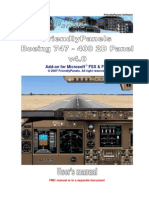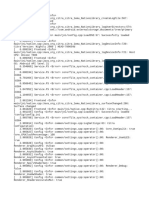0 ratings0% found this document useful (0 votes)
7 viewsPython_Full_Lecture_Notes
The document provides comprehensive notes on Python programming, covering topics such as its introduction, data structures, object-oriented programming, file handling, and popular libraries like NumPy and Pandas. It also touches on web development, data science, automation, and testing in Python. The notes conclude with a summary of the key concepts discussed.
Uploaded by
Swapnil SrivastavaCopyright
© © All Rights Reserved
We take content rights seriously. If you suspect this is your content, claim it here.
Available Formats
Download as TXT, PDF, TXT or read online on Scribd
0 ratings0% found this document useful (0 votes)
7 viewsPython_Full_Lecture_Notes
The document provides comprehensive notes on Python programming, covering topics such as its introduction, data structures, object-oriented programming, file handling, and popular libraries like NumPy and Pandas. It also touches on web development, data science, automation, and testing in Python. The notes conclude with a summary of the key concepts discussed.
Uploaded by
Swapnil SrivastavaCopyright
© © All Rights Reserved
We take content rights seriously. If you suspect this is your content, claim it here.
Available Formats
Download as TXT, PDF, TXT or read online on Scribd
You are on page 1/ 3
Python Programming - Comprehensive Notes
------------------------------------------------------------
Chapter 1: Introduction to Python
- Python is an interpreted, high-level, dynamically typed programming language.
- It supports multiple paradigms, including procedural, object-oriented, and
functional programming.
Chapter 2: Data Structures in Python
- Lists, Tuples, Sets, and Dictionaries.
- How to use list comprehensions.
Chapter 3: Object-Oriented Programming (OOP)
- Classes and Objects
- Inheritance and Polymorphism
Chapter 4: File Handling
- Reading and writing files in Python.
Chapter 5: Python Libraries
- NumPy, Pandas, and Matplotlib.
Chapter 6: Web Development with Flask/Django
Chapter 7: Data Science with Python
Chapter 8: Automation using Python
Chapter 9: Testing in Python
Chapter 10: Conclusion
End of Notes.Python Programming - Comprehensive Notes
------------------------------------------------------------
Chapter 1: Introduction to Python
- Python is an interpreted, high-level, dynamically typed programming language.
- It supports multiple paradigms, including procedural, object-oriented, and
functional programming.
Chapter 2: Data Structures in Python
- Lists, Tuples, Sets, and Dictionaries.
- How to use list comprehensions.
Chapter 3: Object-Oriented Programming (OOP)
- Classes and Objects
- Inheritance and Polymorphism
Chapter 4: File Handling
- Reading and writing files in Python.
Chapter 5: Python Libraries
- NumPy, Pandas, and Matplotlib.
Chapter 6: Web Development with Flask/Django
Chapter 7: Data Science with Python
Chapter 8: Automation using Python
Chapter 9: Testing in Python
Chapter 10: Conclusion
End of Notes.Python Programming - Comprehensive Notes
------------------------------------------------------------
Chapter 1: Introduction to Python
- Python is an interpreted, high-level, dynamically typed programming language.
- It supports multiple paradigms, including procedural, object-oriented, and
functional programming.
Chapter 2: Data Structures in Python
- Lists, Tuples, Sets, and Dictionaries.
- How to use list comprehensions.
Chapter 3: Object-Oriented Programming (OOP)
- Classes and Objects
- Inheritance and Polymorphism
Chapter 4: File Handling
- Reading and writing files in Python.
Chapter 5: Python Libraries
- NumPy, Pandas, and Matplotlib.
Chapter 6: Web Development with Flask/Django
Chapter 7: Data Science with Python
Chapter 8: Automation using Python
Chapter 9: Testing in Python
Chapter 10: Conclusion
End of Notes.Python Programming - Comprehensive Notes
------------------------------------------------------------
Chapter 1: Introduction to Python
- Python is an interpreted, high-level, dynamically typed programming language.
- It supports multiple paradigms, including procedural, object-oriented, and
functional programming.
Chapter 2: Data Structures in Python
- Lists, Tuples, Sets, and Dictionaries.
- How to use list comprehensions.
Chapter 3: Object-Oriented Programming (OOP)
- Classes and Objects
- Inheritance and Polymorphism
Chapter 4: File Handling
- Reading and writing files in Python.
Chapter 5: Python Libraries
- NumPy, Pandas, and Matplotlib.
Chapter 6: Web Development with Flask/Django
Chapter 7: Data Science with Python
Chapter 8: Automation using Python
Chapter 9: Testing in Python
Chapter 10: Conclusion
End of Notes.Python Programming - Comprehensive Notes
------------------------------------------------------------
Chapter 1: Introduction to Python
- Python is an interpreted, high-level, dynamically typed programming language.
- It supports multiple paradigms, including procedural, object-oriented, and
functional programming.
Chapter 2: Data Structures in Python
- Lists, Tuples, Sets, and Dictionaries.
- How to use list comprehensions.
Chapter 3: Object-Oriented Programming (OOP)
- Classes and Objects
- Inheritance and Polymorphism
Chapter 4: File Handling
- Reading and writing files in Python.
Chapter 5: Python Libraries
- NumPy, Pandas, and Matplotlib.
Chapter 6: Web Development with Flask/Django
Chapter 7: Data Science with Python
Chapter 8: Automation using Python
Chapter 9: Testing in Python
Chapter 10: Conclusion
End of Notes.
You might also like
- Rick Sekuloski - PYTHON - Master Python OOP Programming With One Guide Only! A Lot of Coding, Practice and Theory Learn Python With Hands-On Projects (2022)No ratings yetRick Sekuloski - PYTHON - Master Python OOP Programming With One Guide Only! A Lot of Coding, Practice and Theory Learn Python With Hands-On Projects (2022)517 pages
- Introduction To Programming Using Python 1st Edition EbookNo ratings yetIntroduction To Programming Using Python 1st Edition Ebook13 pages
- AirN@v Installation and Consultation Guide V1.186% (7)AirN@v Installation and Consultation Guide V1.130 pages
- Mastering Python Programming: From Basics to Expert ProficiencyFrom EverandMastering Python Programming: From Basics to Expert ProficiencyNo ratings yet
- Python Programming Versatile High Level Language for Rapid DevelopmentNo ratings yetPython Programming Versatile High Level Language for Rapid Development589 pages
- Creating a Python script that covers everythingNo ratings yetCreating a Python script that covers everything5 pages
- AD-141 Introduction To Python Programming: Duration: 4 DaysNo ratings yetAD-141 Introduction To Python Programming: Duration: 4 Days3 pages
- Wepik Exploring The Fundamentals of Python Programming A Comprehensive Seminar 20240414062654IVXXNo ratings yetWepik Exploring The Fundamentals of Python Programming A Comprehensive Seminar 20240414062654IVXX14 pages
- Prepared By: Shubham 21mee104 Mtech (Signal Procssing and Control)No ratings yetPrepared By: Shubham 21mee104 Mtech (Signal Procssing and Control)6 pages
- (Ebook) Python Programming: A Step-by-Step Guide to Learning the Language by Dr. C. K. Dhaliwal, Poonam Rana, T. P. S. Brar - Quickly download the ebook in PDF format for unlimited reading100% (1)(Ebook) Python Programming: A Step-by-Step Guide to Learning the Language by Dr. C. K. Dhaliwal, Poonam Rana, T. P. S. Brar - Quickly download the ebook in PDF format for unlimited reading48 pages
- Python Algorithms Step by Step: A Practical Guide with ExamplesFrom EverandPython Algorithms Step by Step: A Practical Guide with ExamplesNo ratings yet
- GitHub - Mortennobel - Cpp-Cheatsheet - Modern C++ CheatsheetNo ratings yetGitHub - Mortennobel - Cpp-Cheatsheet - Modern C++ Cheatsheet13 pages
- Assignment No1 of System Analysis and Design: Submitted To Submitted byNo ratings yetAssignment No1 of System Analysis and Design: Submitted To Submitted by7 pages
- Veeam Backup Replication Best PracticesNo ratings yetVeeam Backup Replication Best Practices322 pages
- Sri Chaitanya Techno School: Computer ScienceNo ratings yetSri Chaitanya Techno School: Computer Science37 pages
- Computer Security CS 426: Cryptography: Block Ciphers and Encryption ModesNo ratings yetComputer Security CS 426: Cryptography: Block Ciphers and Encryption Modes17 pages
- Billing Management Console Moodle Alta DisponibilidadNo ratings yetBilling Management Console Moodle Alta Disponibilidad8 pages
- 1.Building Dashboards with Dash and PlotlyNo ratings yet1.Building Dashboards with Dash and Plotly28 pages
- Module Quiz - Interactive CSS - CourseraNo ratings yetModule Quiz - Interactive CSS - Coursera1 page

























































































